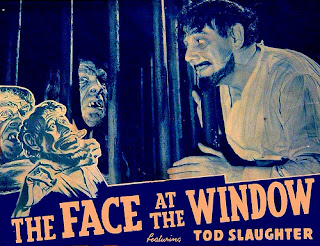“There he stands – condemned by the
hand of his last victim!”
In 1939 Britain’s
maestro of horror melodrama Tod Slaughter re-teamed with director George King to
bring us The Face at the Window,
another generous slice of Grand Guignol horror echoing Slaughter’s stage equivalent
of this style with his Elephant Repertory Company – (see my earlier review of 1936’s
Sweeney Todd). It had already been
filmed a number of times and here was adapted from F. Brooke Warren’s 1897 detective
melodrama play with significant changes to both the central character and the
importance of the investigating policeman. The dialogue was by A.R. Rawlinson
whose previous suspense thrillers had included Hitchcock’s The Man Who knew Too Much (1934) and the screenplay was by Ronald
Fayre.
Set in 1880
Paris, the prologue text indicates we are to treat the film as something of a
romp rather than a heavyweight horror. As we explore the tale of Le Loup, a Wolf Man terrorising the city. we are invited to: "a shudder or a laugh at
the heights of villainy”
Slaughter aims
to give us both in his very best hissable villain as the Chevalier del Gardo, a
dastardly nobleman of means who is a desperately sought-after client of the
banker M. De Brisson (Aubrey Mallalieu – Trader Paterson in Sweeney Todd). De Brisson is terrified
that a just-discovered bank robbery will damage Chevalier’s confidence in
investing with him. He needn’t worry; Chevalier is pointed of beard and agenda,
putting the squeeze on de Brisson for the hand of his lovely daughter Cecile in
return for his much-needed partnership. Cecile is played by Marjorie Taylor who’d
already braved the partnership of Slaughter and King in The Ticket of Leave Man and It’s
Never Too Late To Mend (both 1937).
Unfortunately
for Chevalier, Cecile is secretly in love with her father’s down-trodden
employee Lucien Cortier, (John Warwick) and in case we don’t pick up on their
troubled situation it is rammed home like all of their scenes with a sledge-hammer
of over-wrought melodramatic impact. Their clumsy duologues of exposition are
so breathlessly intense I half-expected them to break into a Les Miserables duet. “What chance have
I, a penniless bank clerk, of obtaining his permission to marry you?” emotes
Cortier, practically throwing himself upon the barricades. Taylor in particular delivers all of her lines irritatingly as though
the stakes are never less than life-or-death at any moment.
Slaughter
meanwhile simmers his stew of dark ingredients with surprising subtlety, only
bubbling over with a thick cackle when required to relish his next plotting
move. His suave King Rat does everything except tie Cecile to the railway tracks
and cover his face with his opera cloak in a quest to make us love to hate him.
He grabs an illicit kiss from Cecile, frames Cortier as the thief behind the
robbery and sows seeds of suspicion in the mind of Robert Adair’s Inspector
Gouffert as to the poor Cortier’s possible financial motive for the crime. This
leads to Cortier reusing a plot device from Sweeney
Todd where he bungles a bid to impersonate a coin-forger to meet Chevalier,
who rumbles him immediately.
So we don’t think
the fun is all Slaughter’s - and to remind us that the film does qualify as a
horror - we have Wallace Evennett’s entertainingly cuckoo and sadly minor cameo
appearance as Professor LeBlanc who channels the customary mad scientist
mind-set: “And they call me mad!” He believes he can harness the power of electricity
to help catch the infamous Loup. Sporting a set of mutton-chop sideburns, he
has more in common with a lycanthrope than he realises. He also becomes a lot
more personally involved in his experiment than he’d bargained for after he
views Harry Terry’s mangled-toothed Face at the titular window. Chevalier stabs
him but not enough to kill. LeBlanc valiantly attempts to write his killer’s
name with his dying vestiges of energy yet the name is incomplete, leaving
Cortier to suddenly demonstrate hidden scientific expertise in administering a
high-voltage temporary wake-up call enough to allow LeBlanc to finish
implicating Chevalier.
Leaving aside
the dubious premise that a freshly-zapped corpse would first of all finish a
note on being revived, Chevalier high-tails it to his underground lair where we
find that the disfigured Face is his foster brother. The police and Cortier
turn up in time to witness a fraternal goodbye as the brothers end up literally
in Seine.
The Face at The Window is entertainingly tongue-in-cheek.
Slaughter’s evident fun in his performance makes up for the over-ripe lovers
and the total reliance on indoor sets which lends the film a TV drama feel
instead of a more suitable cinematic quality.


No comments:
Post a Comment